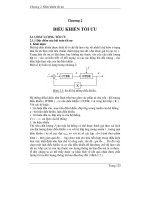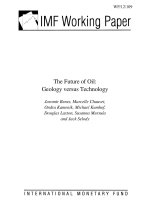Geology chapter2
Bạn đang xem bản rút gọn của tài liệu. Xem và tải ngay bản đầy đủ của tài liệu tại đây (12.01 MB, 76 trang )
GEOL: CHAPTER 2
Plate Tectonics:
A Unifying Theory
Learning Outcomes
LO1: Review early ideas about continental
drift
LO2: Explain the evidence for continental
drift
LO3: Describe Earth’s magnetic field
LO4: Explain paleomagnetism and polar
wandering
LO5: Explain magnetic reversals and
seafloor spreading
Learning Outcomes, cont.
LO6: Explain plate tectonic theory: a
unifying theory
LO7: Identify the three types of plate
boundaries
LO8: Describe hot spots and mantle plumes
LO9: Explain plate movement and motion
Learning Outcomes, cont
LO10: Explain the driving mechanism of
plate tectonics
LO11: Recognize the role of plate tectonics
in the distribution natural resources
LO12: Recognize the role of plate tectonics
in the distribution of life
Continental Drift: Early Ideas
• Alfred Suess, late 19th C, noted similarities
on different continents of:
– Plant fossils
– Glaciation
– Rock sequences
• Gondwanaland as supercontinent
Alfred Wegener
• Continental drift hypothesis, 1915
• Pangaea break-up
• Presented geologic, paleomagnetic,
paleontologic, and climatologic evidence
• Not well received
• Alexander du Toit, 1937: proposed
supercontinent originally at South Pole
Continental Drift Evidence
• Continental fit
– South America and Africa
• Similarity of rock sequences and mountain
ranges
– Appalachian Mountains and mountains in
Europe/Greenland
Continental Drift Evidence, cont.
• Glacial evidence
– Deposits and striations
• Fossil evidence
– Same fossils on all continents
• Paleomagnetic evidence
• But no explanatory mechanism
Earth’s Magnetic Field
• Magnetism
– Spinning electrons in atoms, especially iron
– Moving electricity
• Magnetic field
– Lines of magnetic force
– North and south poles: dipolar
Earth’s Magnetic Field, cont.
• Earth as giant dipole magnet
– Magnetic field strength varies
– Magnetic poles do not align with geographic
poles
– Magnetic pole positions vary over time
Paleomagnetism
and Polar Wandering
• Paleomagnetism: remnant magnetism in
rocks – gives direction and intensity of
Earth’s field when rocks solidified
• Curie point: temperature where ironbearing minerals are magnetized
• Polar wandering: continents moved while
poles stayed relatively stationary
• Continental drift explained the data
Magnetic Reversals
• Magnetic reversals
– Magnetic field weakens and disappears
– Field reappears with pole positions reversed
• Discovered from studying paleomagnetism









